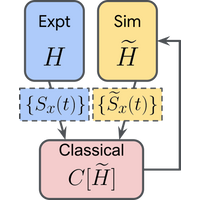Abstract
We propose a quantum algorithm for inferring the molecular nuclear spin Hamiltonian from time-resolved measurements of spin-spin correlators, which can be obtained via nuclear magnetic resonance (NMR). We focus on learning the anisotropic dipolar term of the Hamiltonian, which generates dynamics that are challenging to classically simulate in some contexts. We demonstrate the ability to directly estimate the Jacobian and Hessian of the corresponding learning problem on a quantum computer, allowing us to learn the Hamiltonian parameters. We develop algorithms for performing this computation on both noisy near-term and future fault-tolerant quantum computers. We argue that the former is promising as an early beyond-classical quantum application since it only requires evolution of a local spin Hamiltonian. We investigate the example of a protein (ubiquitin) confined on a membrane as a benchmark of our method. We isolate small spin clusters, demonstrate the convergence of our learning algorithm on one such example, and then investigate the learnability of these clusters as we cross the ergodic to nonergodic phase transition by suppressing the dipolar interaction. We see a clear correspondence between a drop in the multifractal dimension measured across many-body eigenstates of these clusters, and a transition in the structure of the Hessian of the learning cost function (from degenerate to learnable). Our hope is that such quantum computations might enable the interpretation and development of new NMR techniques for analyzing molecular structure.
- Received 21 October 2021
- Accepted 29 August 2022
DOI:https://doi.org/10.1103/PRXQuantum.3.030345
Published by the American Physical Society under the terms of the Creative Commons Attribution 4.0 International license. Further distribution of this work must maintain attribution to the author(s) and the published article's title, journal citation, and DOI.
Published by the American Physical Society
Physics Subject Headings (PhySH)
Popular Summary
Simulating a physical system solves a “forward problem”: given the system parameters, predict an experiment’s outcome. A related question is the “inverse problem”: given an experiment’s outcome, infer the generating system’s parameters. This is a critically important task across science, for example, to determine the product of a chemical reaction or the structure of an unknown substance. This task may be difficult when the system in question is governed by the laws of quantum mechanics and strongly correlated because of the exponential growth of the Hilbert space dimension. However, quantum computers do not suffer from this growth, as their computational state explores an identical Hilbert space.
In this work, we propose quantum-assisted Hamiltonian learning as a potential quantum computing application whenever the system to be learned has strong quantum coherence and is intractable to study classically. We find quantum algorithms for near-term and future fault-tolerant devices using the inference of molecular structure from time-resolved NMR data as an example. We find that a goldilocks region exists in the system parameter space (with deep ties to the localization transition in strongly correlated condensed matter physics): too much chaos makes the system unlearnable, too little makes it classically easy.
This work opens up a realm of potential quantum computing applications, as it applies to any physical system governed by a quantum Hamiltonian that is beyond classical to simulate. The logical followup to this work will be to find more example applications, improve the optimization and circuit methods used, and implement it on a real-world device.



